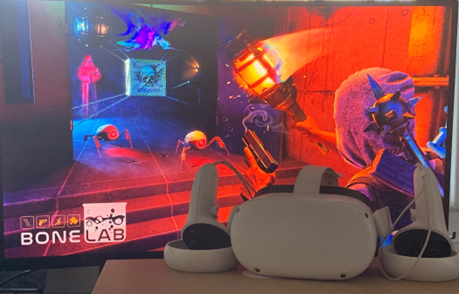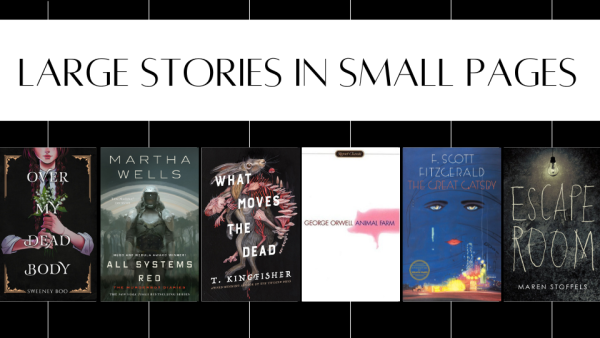BONELAB is an Incredible Game

Photo by Liam Langlan
The game’s main cover illustration, with a Meta Quest 2 Headset stationed in front. The illustration shows various items and enemies in the game.
BONELAB is a sequel to the 2019 virtual reality game BONEWORKS, both developed by the company Stress Level Zero. The most important aspect of both games is what they share in their names: Bones. Unlike other VR games, you have an actual physical body with arms, hands, legs, feet, a torso, and a head; all of which are physical objects that collide with various aspects of the world such as near-by objects or other body parts. This might not sound significant to someone who doesn’t play many virtual reality games, so to put it in perspective: VR games usually have hands which collide with physical objects but phase right through the environment, or in extremely rare circumstances, only have floating hands which collide with the world and physical objects. BONELAB’s physical body systems allow for tons of insane things such as climbing ladders without grabbing the ladder, skipping entire areas of the game just by cleverly climbing around them, defeating enemies by using smaller enemies as blunt objects, and the entire game can be completed without ever grabbing something.
One of BONEWORKS critical flaws was that it was a PCVR only game, which meant that VR games had to be played through a VR headset plugged into a computer. This means that all the computing and rendering was being done on the computer, and the VR headset was basically just a glorified screen strapped to your head. BONELAB on the other hand can be played through a PCVR or with a VR headset, and the only differences are minor graphical downgrades.
The main selling point of BONELAB is its impressive new avatar system. In BONEWORKS you played as one person: Arthur Ford. However, in BONELAB at any point in the game you can swap between 6 avatars, all with wildly different proportions and stats. One character is fast and thin, while another character is HUGE and strong but very slow. Another character is short and can fit through tight spaces, while a different character is very tall with long arms that can climb up tall structures with ease. Plus, one of the best features is the fact that no matter what avatar you are using, the locations of your hands relative to your body is proportional to the placement of your character’s hands relative to their body. By sacrificing the basic VR design principle that the player must always know where their hands are in real life, it gives the illusion that you aren’t just playing as a character; you ARE the character and are inhabiting their body and their proportions.
The game also has an absolute behemoth of content in it. While I would say that the main story mode of BONEWORKS was longer than BONELAB’s main campaign, the sheer volume of side modes in BONELAB makes up for the small handful in BONEWORKS. There are “Parkour” levels where you traverse an environment as fast as possible, “Tactical Trial” levels where you must defeat enemies in each area as quickly as possible, “Arena” levels where you survive waves of enemies, and so many more.
However, the fun doesn’t stop there. BONELAB is built around modding. For those who don’t know what a mod is, it’s basically something created by someone other than the game developers, usually members of the game’s community, that alters the game in some way. For example, you could easily add extra levels, new characters, weapons, and other endless content because the community produces them in abundance for free. In the short time that this game has been released, over a thousand mods have been created. Although BONEWORKS had mods, the game wasn’t built around them, while BONELAB was made to support them.
BONELAB is an incredible, fantastic, insane game. One thing it is not, however, is accessible. There is no teleport movement, you can be moved around by literally anything, and you fall as fast as you would in real life. The game is practically unplayable for people that have motion sickness, and the developers have no intention of changing that. So, if you are new to VR, I wouldn’t really recommend this as your first game. Maybe play some lower impact games first to see how you handle motion sickness, and then, if you don’t suffer from motion sickness, play this game.
So, all in all, while BONELAB is not a game for everyone, for the people that can play it, its rare realistic qualities make it an incredible experience and one of the best VR games ever made. I rate it an 8.5 out of 10 for people who don’t suffer from motion sickness.





